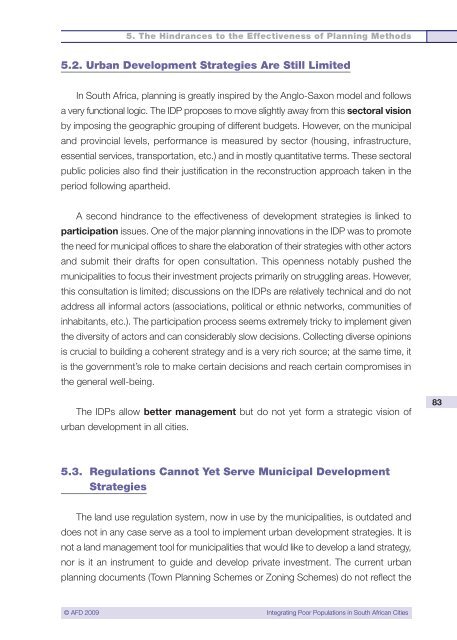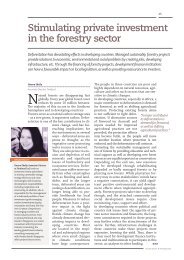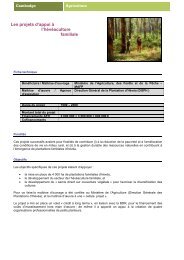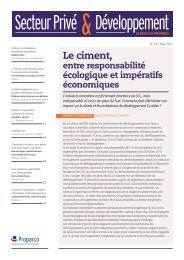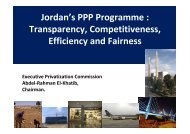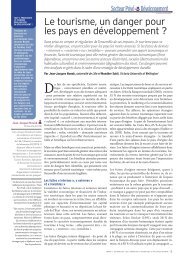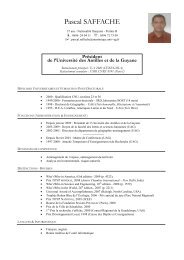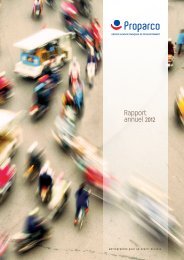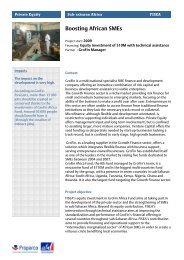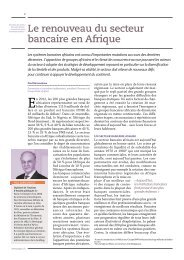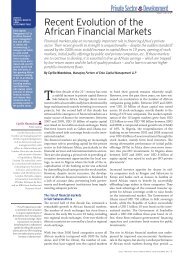Integrating Poor Populations in South African Cities - Agence ...
Integrating Poor Populations in South African Cities - Agence ...
Integrating Poor Populations in South African Cities - Agence ...
You also want an ePaper? Increase the reach of your titles
YUMPU automatically turns print PDFs into web optimized ePapers that Google loves.
5. The H<strong>in</strong>drances to the Effectiveness of Plann<strong>in</strong>g Methods<br />
5.2. Urban Development Strategies Are Still Limited<br />
In <strong>South</strong> Africa, plann<strong>in</strong>g is greatly <strong>in</strong>spired by the Anglo-Saxon model and follows<br />
a very functional logic. The IDP proposes to move slightly away from this sectoral vision<br />
by impos<strong>in</strong>g the geographic group<strong>in</strong>g of different budgets. However, on the municipal<br />
and prov<strong>in</strong>cial levels, performance is measured by sector (hous<strong>in</strong>g, <strong>in</strong>frastructure,<br />
essential services, transportation, etc.) and <strong>in</strong> mostly quantitative terms. These sectoral<br />
public policies also f<strong>in</strong>d their justification <strong>in</strong> the reconstruction approach taken <strong>in</strong> the<br />
period follow<strong>in</strong>g apartheid.<br />
A second h<strong>in</strong>drance to the effectiveness of development strategies is l<strong>in</strong>ked to<br />
participation issues. One of the major plann<strong>in</strong>g <strong>in</strong>novations <strong>in</strong> the IDP was to promote<br />
the need for municipal offices to share the elaboration of their strategies with other actors<br />
and submit their drafts for open consultation. This openness notably pushed the<br />
municipalities to focus their <strong>in</strong>vestment projects primarily on struggl<strong>in</strong>g areas. However,<br />
this consultation is limited; discussions on the IDPs are relatively technical and do not<br />
address all <strong>in</strong>formal actors (associations, political or ethnic networks, communities of<br />
<strong>in</strong>habitants, etc.). The participation process seems extremely tricky to implement given<br />
the diversity of actors and can considerably slow decisions. Collect<strong>in</strong>g diverse op<strong>in</strong>ions<br />
is crucial to build<strong>in</strong>g a coherent strategy and is a very rich source; at the same time, it<br />
is the government’s role to make certa<strong>in</strong> decisions and reach certa<strong>in</strong> compromises <strong>in</strong><br />
the general well-be<strong>in</strong>g.<br />
The IDPs allow better management but do not yet form a strategic vision of<br />
urban development <strong>in</strong> all cities.<br />
83<br />
5.3. Regulations Cannot Yet Serve Municipal Development<br />
Strategies<br />
The land use regulation system, now <strong>in</strong> use by the municipalities, is outdated and<br />
does not <strong>in</strong> any case serve as a tool to implement urban development strategies. It is<br />
not a land management tool for municipalities that would like to develop a land strategy,<br />
nor is it an <strong>in</strong>strument to guide and develop private <strong>in</strong>vestment. The current urban<br />
plann<strong>in</strong>g documents (Town Plann<strong>in</strong>g Schemes or Zon<strong>in</strong>g Schemes) do not reflect the<br />
© AFD 2009 <strong>Integrat<strong>in</strong>g</strong> <strong>Poor</strong> <strong>Populations</strong> <strong>in</strong> <strong>South</strong> <strong>African</strong> <strong>Cities</strong>


